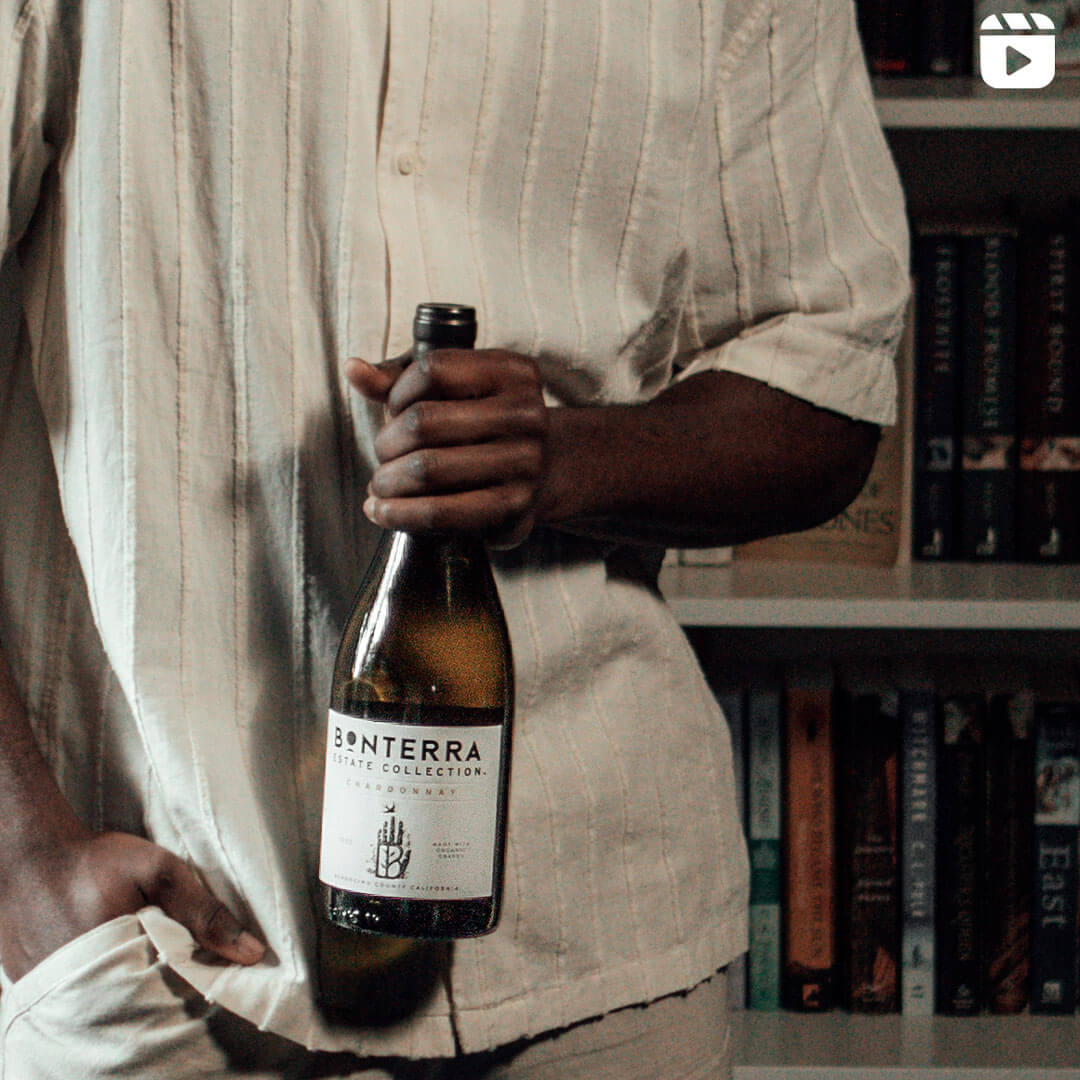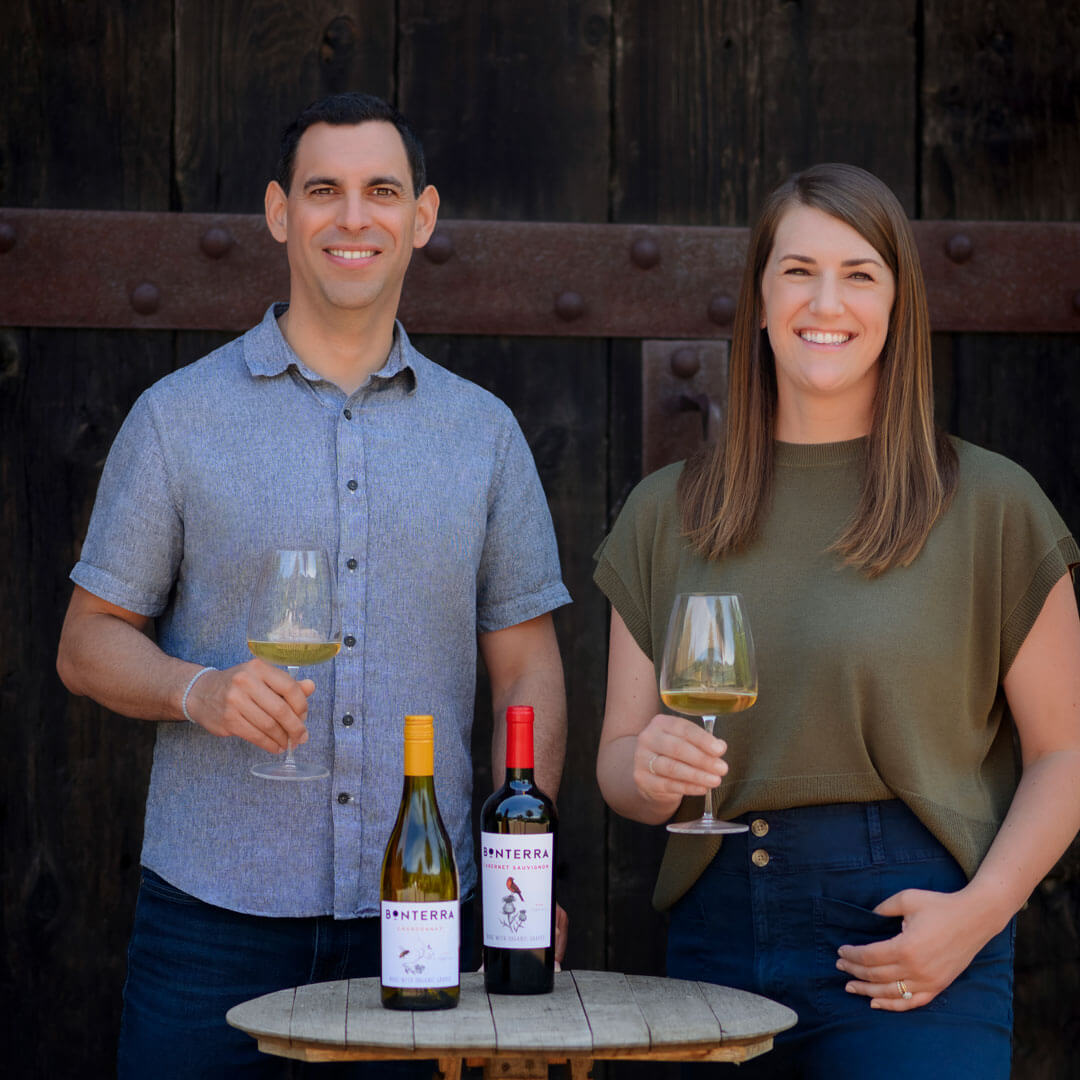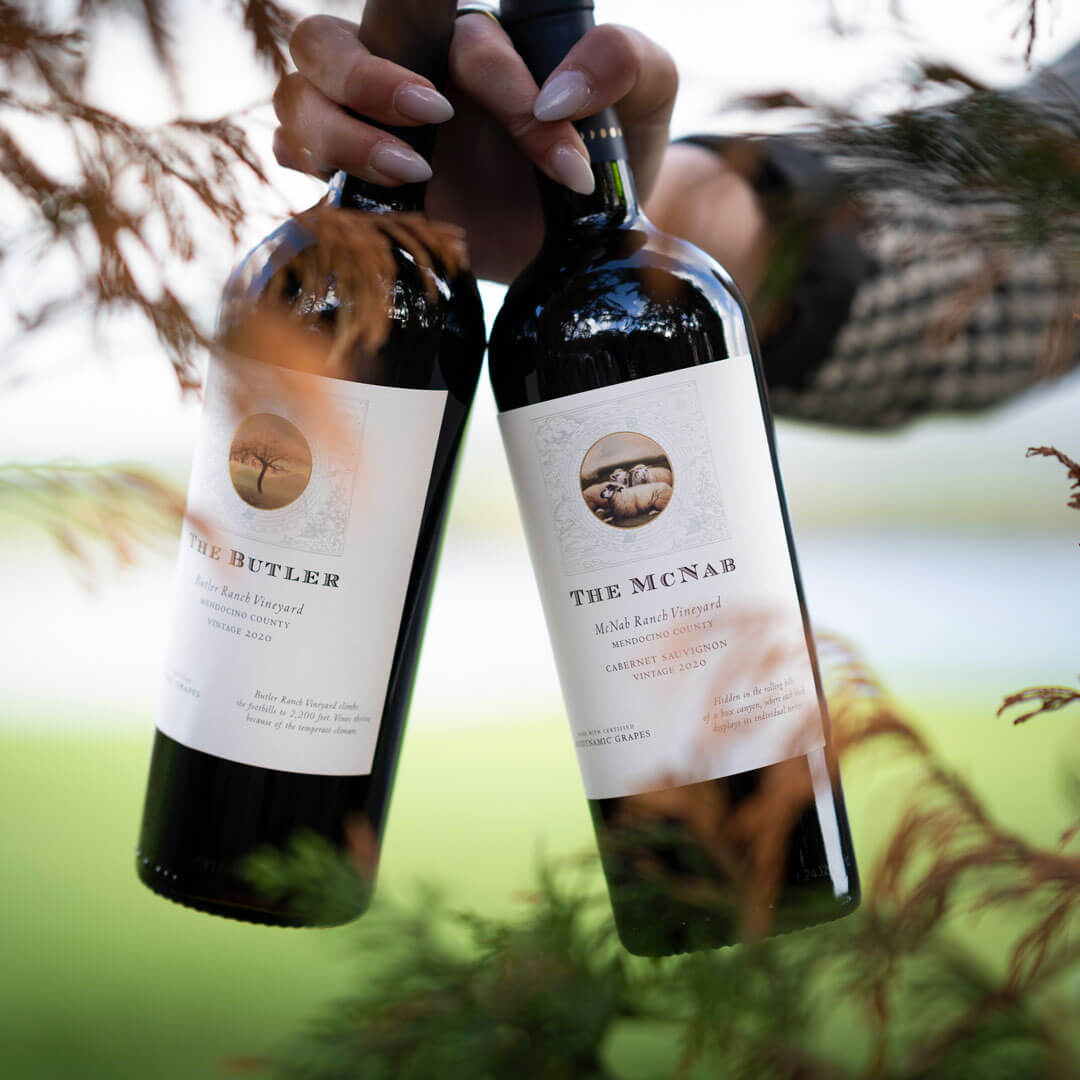In the rolling hills of Bordeaux, two noble grapes have shaped the world of wine for centuries. Cabernet Sauvignon and Merlot, both originating from one of France’s most celebrated wine regions, represent different expressions of red wine craftsmanship—each with its own distinct personality and appeal.
These two varietals are often compared because they frequently appear together in blends, where their contrasting characteristics create harmony. But getting to know them individually helps you find what truly fits your taste, mood, or meal.
At Bonterra, we craft both varietals with organic and regenerative farming practices, inviting each one to express its truest character—from the ground up. If you’re exploring different types of red wine, Cabernet Sauvignon and Merlot are two foundational grapes to understand.
The Key Differences in Flavor Profiles
The comparison between Cabernet Sauvignon vs. Merlot begins with flavor. Each grape tells its own story through a distinct taste profile that emerges from the vineyard and evolves in the cellar.
Cabernet Sauvignon Tasting Notes
Cabernet Sauvignon commands attention with its bold presence. This so-called noble varietal delivers dark fruit flavors—think black cherry, blackcurrant, and plum—layered with complexity that unfolds in the glass. The wine’s firm tannins create that pleasantly drying sensation on your palate, similar to that brought on by strong black tea.
Our Bonterra Cabernet Sauvignon showcases these classic characteristics while adding nuances of spice and toast from careful oak aging. You’ll often detect herbal notes such as hints of eucalyptus or dried herbs that add dimension to the wine’s structure. These secondary flavors emerge from both the grape’s natural character and the terroir of our organic vineyards.
Some newcomers to red wine may wonder, “Is Cabernet Sauvignon sweet?” While it often offers ripe dark fruit notes, true Cabernet Sauvignon is typically dry, with its richness coming from tannins and oak influence rather than sugar. If you’ve ever asked, “Is Merlot sweet or dry?”, that’s a great comparison point—the answer often lies in the varietal’s structure and winemaking style.
The intensity of Cabernet Sauvignon makes it immediately recognizable. Each sip reveals layers: first the fruit, then the spice, finally the lasting finish that invites another taste.
Merlot Tasting Notes
Merlot wines take a gentler approach. Where Cabernet commands, Merlot charms with softer red fruit character—strawberry, raspberry, and cherry notes that feel approachable and inviting. The wine’s smooth mouthfeel creates an entirely different experience on the palate.
Our Bonterra Merlot expresses rich boysenberry and plum notes accented by dried herbs, with subtle hints of chocolate and vanilla that add warmth without overwhelming. The tannins remain present but polished, creating what we call a “cocoa cashmere mouthfeel”—luxurious yet comforting.
This softer profile makes Merlot more immediately accessible to many wine drinkers. To dive deeper into what makes this varietal special, explore what a Merlot wine is and how its flavor profile differs from other reds. The fruit shines brighter, the structure feels rounder, and the overall impression is one of elegance rather than power.
Body, Tannins, and Acidity in Each Wine
To really understand the difference between Cabernet Sauvignon and Merlot, it helps to look beyond flavor and into structure. Body, tannins, and acidity all shape how a wine feels—and how well it plays with food.
Cabernet Sauvignon typically presents a full body with robust tannins. These tannins—compounds from grape skins, seeds, and stems—create structure and allow the wine to age gracefully. Cabernet grapes’ thick skins produce more tannins than many other varietals, resulting in that characteristic firmness. Cabernet also maintains good acidity, which provides freshness, helps the wine pair beautifully with rich, fatty foods, and allows for longer-term aging.
Merlot has medium to full body with soft, round tannins and just enough acidity to keep its fruit-forward character feeling lifted. With naturally thinner skins, the grapes produce wines that are smooth and easy to enjoy even when young, no waiting required. That kind of early ease, combined with plush texture and gentle balance, makes Merlot one of the most versatile reds to share at the table or savor on its own.
Together, these traits—body, tannins, and acidity—shape how Cabernet and Merlot feel in your mouth and how they evolve with each sip. Cabernet’s higher tannins need time to soften, either through aging or by pairing with protein and fat. Merlot’s gentler structure allows it to shine with a wider range of foods and occasions.
Food Pairings for Cabernet Sauvignon vs. Merlot
Cabernet vs. Merlot: how to pair? The structural differences between these varietals naturally lead to different pairing opportunities. Each wine finds its perfect match with specific dishes that complement its character. For more pairing inspiration, explore our guide to red wine pairings, which can make every meal memorable.
Cabernet Sauvignon Pairings
Cabernet Sauvignon wines have bold tannins and structure, making them the ideal companion for rich, hearty fare. The wine’s tannins act as palate cleansers, cutting through the richness of fatty meats and preparing your taste buds for the next bite.
Prime rib becomes a revelation alongside Cabernet. The wine’s structured tannins soften when paired with the meat’s richness, while Cabernet’s dark fruit flavors enhance the beef’s savory character. Grilled ribeye steak, braised short ribs, and herb-crusted lamb all create harmonious pairings with this powerful varietal.
Bold sauces—think rich demi-glace or mushroom-based preparations—stand up to Cabernet’s intensity without overwhelming the wine. The grape’s natural affinity for umami flavors makes it excellent with aged cheeses like Manchego or mature Gouda, where both the wine’s and cheese’s complexity shines through.
At Bonterra, we love pairing our Estate Cabernet Sauvignon with wild mushroom risotto during cooler months. The wine’s earthy notes complement the mushrooms while its structure supports the dish’s creamy richness.
Merlot Pairings
Merlot’s softer profile creates different pairing possibilities. The wine’s approachable tannins and fruit-forward character make it wonderfully flexible at the dinner table.
Herb-roasted chicken finds a perfect partner in Merlot. The wine’s plum notes enhance the roasted flavors while its polished tannins maintain elegance without overpowering this lighter-bodied protein. Duck, turkey, and pork also pair beautifully, as Merlot’s fruit-driven character complements rather than competes.
Pasta dishes with tomato-based sauces benefit from Merlot’s moderate acidity and smooth texture. The wine’s chocolate and vanilla hints—courtesy of gentle oak aging—add depth to dishes featuring mushrooms or herbs. Butternut squash risotto, one of our favorite cozy-weather pairings, showcases how Merlot’s juicy dark fruit flavors brighten rustic, hearty preparations.
Creamy dishes—from pasta alfredo to risotto—work surprisingly well with Merlot. The wine’s structure supports richness while its fruit provides balance, creating a harmonious experience on the palate.
Aging Potential and Drinking Window
Time transforms both varietals differently, offering distinct experiences depending on when you open the bottle.
Cabernet Sauvignon possesses remarkable aging potential. The grape’s firm tannins, good acidity, and concentrated flavors allow it to evolve gracefully over many years. Young Cabernet can feel tight and structured, but with age, those tannins soften and integrate. Secondary aromas develop—leather, tobacco, dried herbs—adding layers of complexity. Well-made Cabernet Sauvignon can age for decades, revealing new facets with each passing year.
Don’t want to wait for a young Cabernet to open up? Decanting is a great shortcut to bottle aging, helping soften the wine with a little oxygen and a little patience. No fancy gear required: a clean pitcher or Mason jar does the trick just fine.
Merlot offers flexibility in its drinking window. While capable of aging, particularly in Bordeaux-style blends, Merlot often shows beautifully in its youth. The softer tannins mean you can enjoy the wine sooner without waiting for harsh edges to mellow. That said, quality Merlot still benefits from a bit of time in the bottle, integrating oak influences and building complexity.
This difference in aging potential doesn’t indicate quality—rather, it reflects each varietal’s natural character. Cabernet rewards patience, while Merlot offers both immediate pleasure and the potential for evolution.
Choosing the Right Wine for You
Selecting between Cabernet Sauvignon vs. Merlot ultimately comes down to understanding your preferences and the moment you’re creating.
If you gravitate toward bold, structured wines that make a statement, Cabernet Sauvignon likely speaks to your palate. Those who appreciate wines with firm tannins, intense dark fruit, and the potential for complexity with age will find Cabernet deeply satisfying. The varietal suits occasions when you want a wine that stands up to rich foods or contemplative sipping by the fire.
If you prefer approachable, fruit-forward wines with smooth texture, Merlot is your ideal choice. Wine lovers who seek elegance without intensity, or those newer to red wine, often find Merlot’s softer profile more immediately appealing. The varietal works beautifully for casual weeknight dinners, outdoor gatherings, or any occasion where you want a wine that’s sophisticated yet relaxed.
Consider the season and setting as well. Cabernet Sauvignon feels particularly fitting during cooler months, paired with heartier fare and enjoyed at a leisurely pace. Merlot’s versatility makes it wonderful year-round, though its smooth character especially suits fall celebrations and harvest dinners.
Don’t hesitate to explore both varietals from our collection. Tasting them side by side reveals their differences most clearly, helping you understand which characteristics appeal to your unique palate.
Finding Your Perfect Red Between Cabernet Sauvignon and Merlot
The question of Cabernet Sauvignon vs. Merlot doesn’t demand a single answer. Both varietals offer distinct pleasures, each expressing red wine’s potential through different lenses.
Cabernet Sauvignon delivers power and structure—bold dark fruit, firm tannins, and remarkable aging potential. It’s the wine for special occasions, rich foods, and those who appreciate intensity with complexity. Merlot offers softer charm—approachable red fruit, smooth texture, and flexible food-pairing options. It’s the wine for everyday elegance, diverse dishes, and those who value drinkability with sophistication.
When it comes to our organic winery and Bonterra wine, we believe both varietals deserve a place in your wine journey. Our commitment to organic and regenerative farming allows each grape to express its truest character, free from synthetic inputs that might mask terroir. Whether you choose the bold confidence of our Cabernet Sauvignon or the smooth elegance of our Merlot, you’re experiencing wines that honor both the land and the craft.
We invite you to explore both styles. Check out our wine online to discover which expression speaks to your palate, or consider our wine club if you find that both varietals have their perfect moment in your wine experience.
REFERENCES
Wine Enthusiast. (n.d.). Everything You Need to Know About Merlot. Wine Enthusiast.
https://www.wineenthusiast.com/basics/everything-you-need-to-know-about-merlot/
Wine Folly. (n.d.). Cabernet Sauvignon: The World’s Most Popular Red Wine. WineFolly.com.
https://winefolly.com/grapes/cabernet-sauvignon/Wine & Spirit Education Trust (WSET). (2021, July 8). Understanding Tannins in Wine. WSET Global. https://www.wsetglobal.com/knowledge-centre/blog/2021/july/08/understanding-tannins-in-wine/




